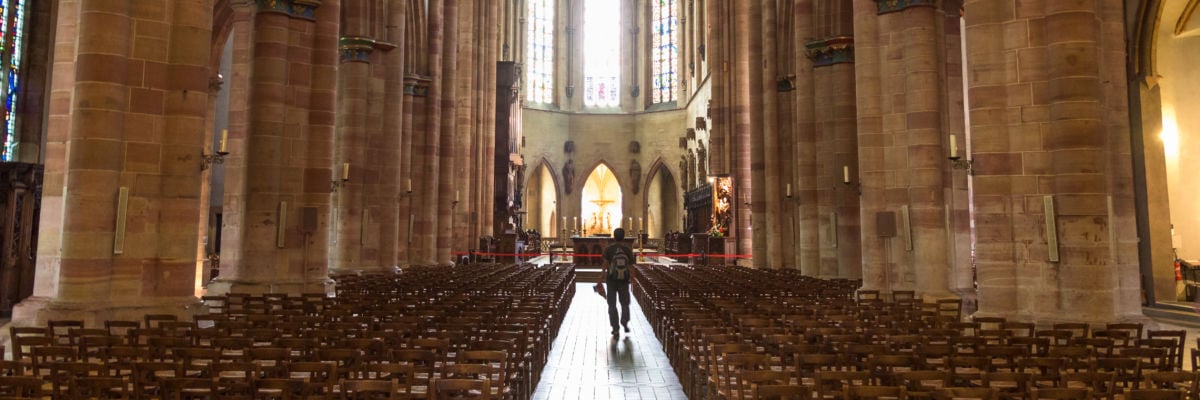
In medieval society, it was possible, albeit uncommon, for people from the lower classes to rise above their station. The Church provided the vehicle through which this upward movement could be achieved. Although medieval society was highly class-stratified, the Church exemplified a meritocracy. People’s ability and fidelity mattered more than their parentage.
The unique life of Abbot Suger of St. Denis (c. 1081-1151) illustrates this aspect of the Middle Ages. Despite his lower-class status as the son of a serf, Suger became abbot of the royal abbey of St. Denis (near Paris), adviser to the king and popes, regent of France, and the originator of a distinctive architectural style that spawned the magnificent cathedrals of Europe.
As a young boy, Suger attended the abbey school at St. Denis with the future Louis VI, the Fat (r. 1108-1137) and they became lifelong friends. The abbey contained the relics of St. Denis, the beheaded third-century bishop and martyr who evangelized Paris and the surrounding region. King Dagobert I, king of all the Franks (r. 629-634), founded the abbey church and was the first of many French monarchs buried there.
Suger, recognized for his diligence and brilliance, became secretary to Abbot Adam of the abbey and continued his rise through the ecclesial ranks. He was elected abbot of St. Denis and held the position for nearly thirty years before his death. He also spent time in Rome, where he attended the First Lateran Council in 1123.
Upon his return to France, Suger embarked on a reform of the abbey, which he initiated due to a reprimand received from the great St. Bernard of Clairvaux (1090-1153). Bernard chastised Suger for his lax and worldly focus and behavior by telling him to “live as a monk serving God as minister of his king, rather than as a minister who, by chance, happened to be a Benedictine.” Bernard was concerned that Suger was focused more on royal politics than on spiritual matters—an accurate assessment at the time.
As part of his reform efforts, Suger undertook a major renovation of the abbey church at St. Denis. Suger wrote a book detailing the construction efforts, which provides an invaluable testimony to the building process. In one humorous story, Suger recounts how his builders told him there were not trees tall enough to provide the length he wanted for the roof. Suger decided to take the pessimistic carpenters into the woods, wherein he found twelve trees of the required length and ordered them cut and dragged to the building site.
In the centuries before the construction at St. Denis, Church architecture borrowed heavily from Roman designs. The Roman basilica with its long nave, aisles divided by columns, and covered wooden roof was the model for Christian churches for centuries. After the collapse of Western imperial power in the late fifth century, a new style of architecture, known as Romanesque, developed. This style utilized thick walls; narrow windows (which limited the amount of light in the building); and a wood roof of restricted height, which was vulnerable to the hazard of fire.
Suger desired a different design for his new church, which led to several architectural innovations and produced a new style of ecclesial architecture. Suger’s innovations involved increasing the height of the walls in order to provide more room for windows, which produced more light in the interior. Another featured characteristic of the new architectural style was ribbed rather than barrel vaulting. The ribbed vault allowed for an increase in wall height and interior space but placed significant pressure on walls. Architects and engineers countered the outward thrust of the walls by creating the flying buttress, which became the distinctive characteristic of these new cathedrals. The new style gave the building a sense of soaring toward heaven.
Italians during the Renaissance would deem this new architectural style Gothic, but it is perhaps more appropriately called the “French” style, after France, where it originated and flourished. Suger believed that architectural beauty was an earthly reflection of God and held that humanity could comprehend God, who is beauty itself, through sensory things. In essence, Suger believed that beautiful material objects (like French-style cathedrals) assisted humanity in knowing and loving God.
The French took their cathedral-building seriously, and by the mid-thirteenth century, there were fifty cathedrals under construction. Cathedral-building was a social undertaking, as a town’s populace frequently provided the manpower required to build the massive structures. For example, the inhabitants of Chartres in 1144 harnessed themselves to carts to deliver stone to the construction site, and people from the surrounding countryside brought food and supplies for the builders.
The new style spread from France throughout Christendom and became a definitive feature of the Middle Ages. French-style cathedrals illustrated the deep and vibrant faith of medieval people and remain a testament to their intellectual and physical activity oriented towards God.
A few years before his death, Suger was appointed regent of France by King Louis VII (r. 1137-1180), when the king participated in the Second Crusade (1147-1149). Suger counseled against King Louis’s departure but served faithfully while the monarch was away. Upon his return from the unsuccessful Crusade—indeed, it ended in disaster—Louis rewarded Suger’s faithfulness by giving him the title “Father of the Country.” The abbot and royal adviser began preparations for another expedition to the Holy Land, but he died as the army was assembling.
Abbot Suger of St. Denis, the son of a serf, rose above his lowly origin to become one of the most influential men in the kingdom of France. He was a devoted son of the Church, and his love for Christ moved him to develop an architectural style that exemplifies the beauty and immensity of God. He was a short man, but his impact on Western civilization was immense, as one friend remarked in an obituary: “He refused in his smallness, to be a small man.”



